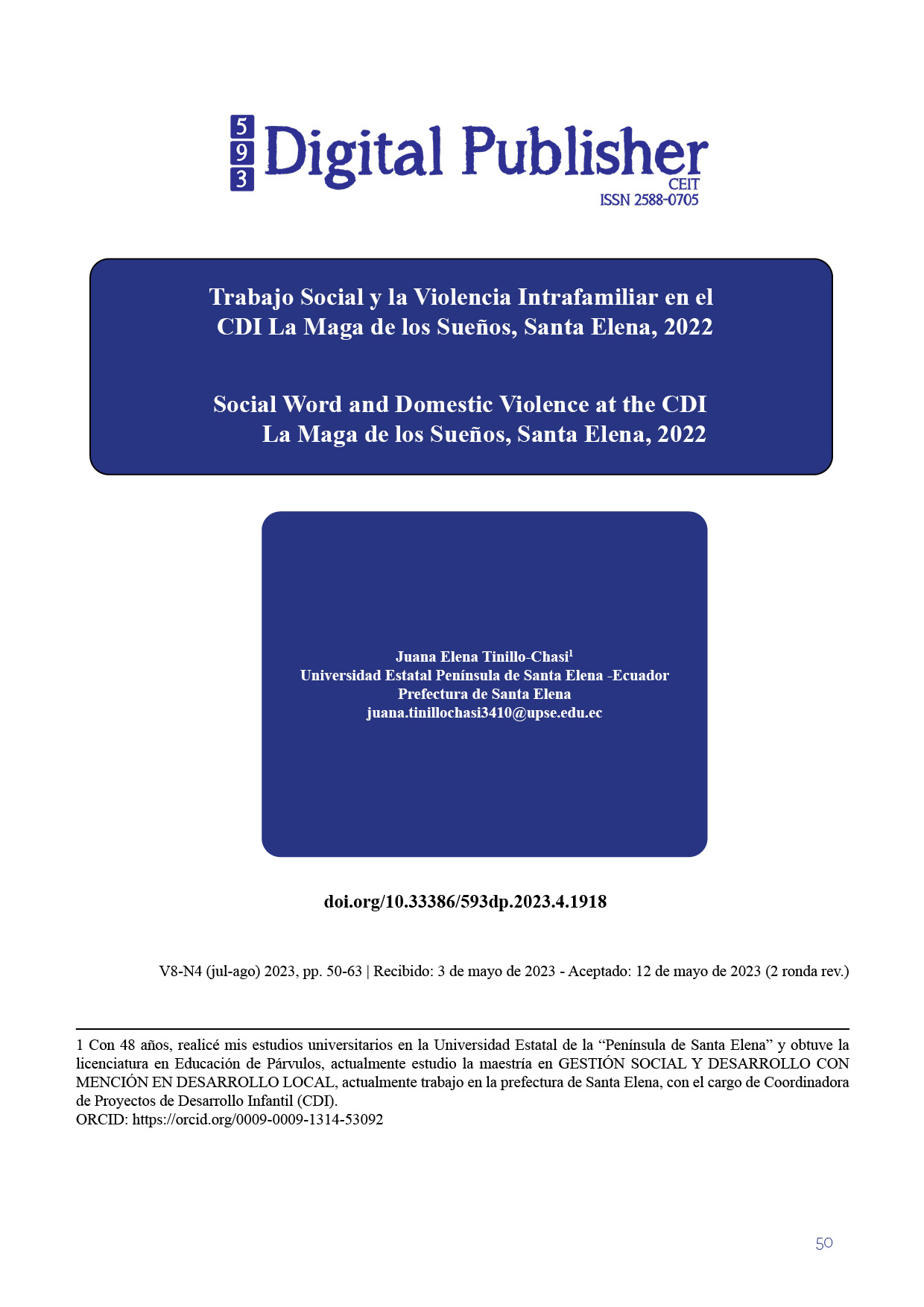Social Word and Domestic Violence at the CDI La Maga de los Sueños, Santa Elena, 2022
Main Article Content
Abstract
Social work is essential in the fight against intrafamily violence, since its focus on human well-being and social justice allows addressing the underlying causes of this type of violence. Social workers can identify and care for victims, provide guidance and support, and promote the prevention and peaceful resolution of conflicts in homes, contributing to a more just and peaceful society. The objective of this research is to verify the correlation that exists between the two variables, in order to formulate strategies that reduce cases of intrafamily violence in the study population, through efficient management by the social worker. The applied methodology was quantitative with a correlational scope. The population corresponded to the 25 families that are part of the program. Among the main conclusions is that, in the study context, there is an inverse relationship between the approaches of the research variables, that is, as long as there are efficient actions on the part of the social worker, in terms of intrafamily violence, the cases tend to decrease, increasing the well-being of families.
Downloads
Article Details

This work is licensed under a Creative Commons Attribution-NonCommercial-ShareAlike 4.0 International License.
1. Derechos de autor
Las obras que se publican en 593 Digital Publisher CEIT están sujetas a los siguientes términos:
1.1. 593 Digital Publisher CEIT, conserva los derechos patrimoniales (copyright) de las obras publicadas, favorece y permite la reutilización de las mismas bajo la licencia Licencia Creative Commons 4.0 de Reconocimiento-NoComercial-CompartirIgual 4.0, por lo cual se pueden copiar, usar, difundir, transmitir y exponer públicamente, siempre que:
1.1.a. Se cite la autoría y fuente original de su publicación (revista, editorial, URL).
1.1.b. No se usen para fines comerciales u onerosos.
1.1.c. Se mencione la existencia y especificaciones de esta licencia de uso.
References
Acinas, H., & Riaño, Y. (2016). Trabajo Social y violencia de género. Anales de la Asociación de Psicología y Educación, 95-102.
Acosta, L., & Fernández, E. (2018). La violencia intrafamiliar: un abordaje integral desde el trabajo social. Revista Ciencias Sociales, 110-127.
American Psychological Association (APA). (2013). The impact of violence on children. . APA.
Assis, S., Avanci, J., Pesce, R., Ximenes, L., & Oliveira, R. (2015). Efficacy of a parental training program on reducing physical child abuse: a randomized controlled trial in Brazil. Revista Panamericana de Salud Pública.
Child Abuse & Neglect. (2017). Child Abuse & Neglect. Elsevier.
Chung, H. (2020). El papel del trabajador social en la violencia intrafamiliar. Journal of Social Work Practice, 383-394.
De la Cuesta, L. (2020). Trabajo Social y Violencia de Género. Revista de Trabajo Social y Acción Socia, 43-55.
Federación Internacional de Trabajadores Sociales. (2014). Código de Ética de la Federación Internacional de Trabajadores Sociales. IFSW.
Federación Internacional de Trabajadores Sociales. (2019). Código de Práctica de la Federación Internacional de Trabajadores Sociales. IFSW.
George, D., & Mallery, P. (2003). SPSS for Windows step by step: A simple guide and reference. Boston: Allyn and Bacon.
Gómez-Berrocal, C., & Hidalgo-Ruiz, M. (2019). La violencia de género intrafamiliar: una revisión bibliográfica. Revista de Investigación en Educación, 115-129.
Gómez-Restrepo, C., Palacio Acosta, C., & Toro, J. (2017). Trabajo social y violencia intrafamiliar. Revista de psiquiatría y salud mental, 1-6.
Herrera, S. (2018). Trabajo Social y violencia intrafamiliar.Una revisión de la literatura. . Cuadernos de Trabajo Socia, 321-334.
Howe, D. (2009). Teoría del trabajo social. Barcelona: GEDISA.
Klevens, J., & Roca, E. (2014). La violencia doméstica. En Tratado de Medicina de Urgencias y Emergencias .
Kurbatfinski, S. (2017). The Evaluation of a Domestic Abuse Response Team Program in an Emergency Department. Journal of Family Violence, 3-4.
Largo-Avilés, C., García, M., Pazmiño, D., & Gómez-Salgado, J. (2018). Protective Factors Against Child Abuse and Neglect in Ecuador: Analysis of Secondary Data from Children Attending Child Development Centers. International journal of environmental research and public health,.
Lee, N. (2006). Metodología de la investigación en trabajo social. México: Trillas.
León, M., Guerrero, M., & Martinic, M. (2017). Effects of a psychosocial support program for vulnerable families attending child development centers in Chile. Child & family social work.
Logan-Green, P., & Bowersox, 1. (2019). Social work’s role in addressing domestic violence. Social Work, 119-123.
Mejía, N. (2017). La violencia intrafamiliar: un desafío para el trabajo social en la escuela. Revista Científica de Educación, 139-150.
Mendenhall, R., & Heller, N. (2015). Enhancing social worker responses to intimate partner violence: are skill-building workshops helpful? Journal of Social Service Research, 166-182.
Ministerio de Educación. (2018). Centros de Desarrollo Infantil (CDI). https://educacion.gob.ec/centros-de-desarrollo-infantil-cdi/
Morales, J. (2019). El trabajo social en la atención a la violencia de género. Trabajo Social Global, 103-119.
National Institute of Justice. (2000). Children’s exposure to domestic violence. . NIJ.
ONU Mujeres. (2020). La COVID-19 y la violencia contra las mujeres y las niñas: Prevéngala y respóndala. ONU.
Organización Internacional del Trabajo. (2016). La violencia y el acoso en el mundo del trabajo: Informe de la OIT. OIT.
Organización Mundial de la Salud (OMS). (2013). Global and regional estimates of violence against women: prevalence and health effects of intimate partner violence and non-partner sexual violence. OMS.
Organización Mundial de la Salud. (2012). Informe mundial sobre la violencia y la salud.
Organización Mundial de la Salud. (2013). Respuesta de la OMS a la violencia de género. OMS.
Organización Mundial de la Salud. (2014). Global status report on alcohol and health 2014. OMS.
Organización Mundial de la Salud. (2021). Desarrollo infantil temprano. OMS.
Ortiz, L. (2019). Intervención del Trabajo Social en la Atención a la Violencia Intrafamiliar. Revista Latinoamericana de Trabajo Social, 131-145.
Rogowski, S. (2020). Social Work. England: Oxford University Press.
Sánchez, D. (2018). La violencia intrafamiliar en la cultura patriarcal. Revista de Investigación Académica, 78-89.
Sullivan, C., Bybee, D., Allen, N., & Findley, P. (2002). A typology of multifaceted empowerment strategies: Implications for implementing policy and practice. Journal of Community Psychology, 379-398.
United Nations Office on Drugs and Crime. (2013). Global study on homicide 2013: trends, contexts, data. UNODC.
Welch, & Comer. (1988). Coeficiente de Alpha de Cronbach. Recuperado de http://www.uv.es/~friasnav/AlfaCronbach.pdf.
World Health Organization (WHO). (2017). Violence against women and alcohol. WHO.


